The Acer Swift 3 SF315-41 Review: Ryzen Meets Laptop
by Brett Howse on May 3, 2018 8:00 AM EST- Posted in
- Laptops
- Acer
- AMD
- Ryzen
- Ryzen Mobile
- Raven Ridge
Display Analysis
Acer has outfitted the Swift 3 with a 1920x1080 IPS display, which is a big improvement over the TN displays that used to plague AMD based systems. This is a display with a Corning Gorilla Glass cover, but there’s no touch.
To test the display capabilities, we leverage SpectraCal’s CalMAN software suite, along with an X-Rite i1DisplayPro colorimeter for brightness and contrast, and an X-Rite i1Pro2 spectrophotometer for color accuracy testing.
Brightness and Contrast
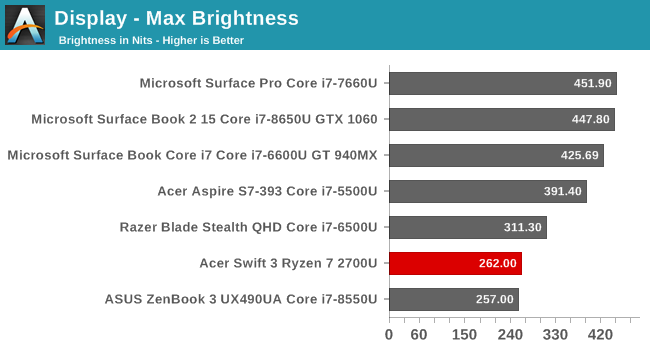
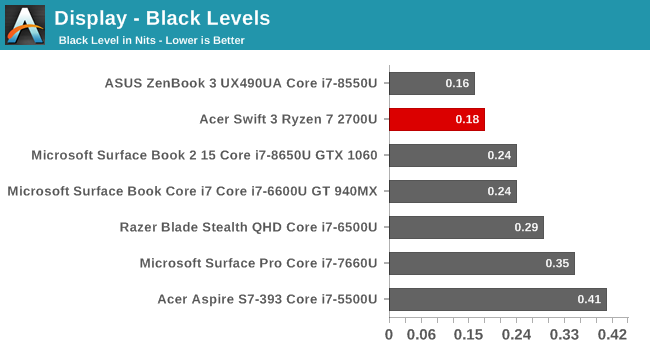
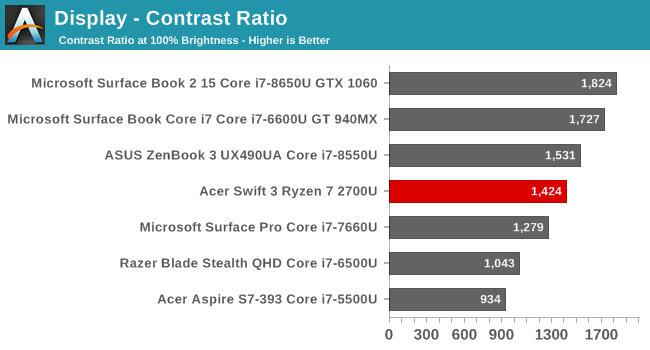
The Acer doesn’t come close to other laptops in terms of overall brightness, at just 260 nits, so outdoor usage, especially with the glass over the display, is going to be a challenge, but the black levels are very good, so the contrast ratio is very solid. The display goes down to 20 nits, which is still fairly bright, but would be fine in a dim room. This isn’t a tablet you’d use in bed, so there’s likely no need to go down to the low single-digits we see on some devices.
Grayscale
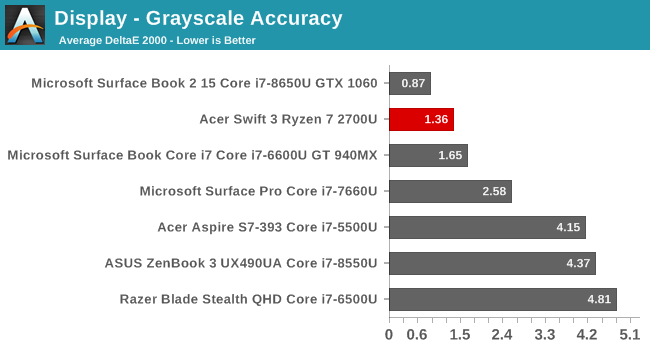
Here was a surprise. Acer absolutely delivers in terms of grayscale out of the box, with fantastic RGB balance, and a great average result without the big spikes we sometimes see closer to 100% white on some systems. Gamma is a bit low, but still close to the 2.2 level we’d like to see.
Gamut

Here’s a good sign that Acer considers the Swift 3 a lower-tier model. This display doesn’t even come close to covering the entire sRGB gamut, with all three primary colors short of the target at 100%. The blue results are especially terrible, with an error level of 17.6 at 100% when you’re looking for a result under 3.0.
Saturation

This is just a more comprehensive view of the gamut results, so it’s not surprising to see a less than amazing average error level here too. All of the sweeps are well short of the targets, and the error levels start to creep up very early.
Gretag Macbeth
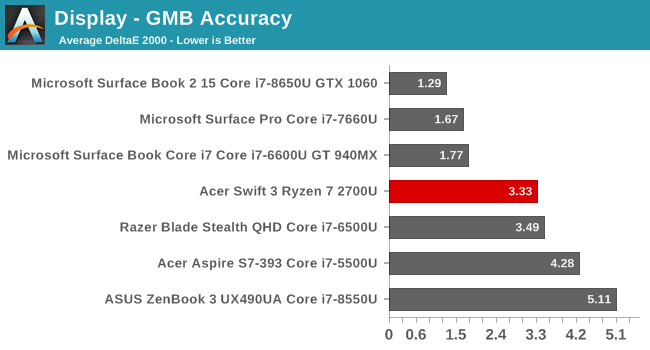
The GMB test is the most comprehensive, covering not just the primaries and secondaries, but also various colors in between, and the important skin tones. With the lack of gamut coverage, there’s plenty of errors here, but for the most part, they are a lot less severe than the pure primaries.
The following image shows the target color on the bottom and the actual displayed color on the top. This image will be relative though because any errors in your own display will prevent an absolute look at the differences, but you can still clearly see the excellent grayscale results, marred by the lack of gamut coverage on the deeper colors.
Display Conclusion
This is definitely a mixed bag conclusion. Acer is targeting a lower price bracket on the Swift 3, and that shows when you see a display that is this far short of covering all of sRGB, but at the same time, they offer some of the best out of the box grayscale results we’ve seen outside of perhaps a Surface device. Still, at a $949 MSRP for the laptop tested, it would be nice to see a display that can cover all of sRGB.
The 1920x1080 resolution is the perfect fit for this laptop as well, allowing Acer to keep the price down, but still offering enough resolution for a 15.6-inch device. You can easily run this at 100% scaling, which avoids any issues you’d see with higher resolution laptops, although most of those issues are a huge problem anymore.















78 Comments
View All Comments
kaidenshi - Thursday, May 3, 2018 - link
640KB is enough for anyone.In all seriousness, this is a midrange laptop and 8GB is midrange these days. Unless you're trying to use it for containers/VMs, 8GB is plenty for the kind of use case a laptop like this will see.
Now, if they included the right GPU to make it a gaming laptop, I'd love to see it come with 16GB with the option of 32GB. But in this case, 8GB is plenty.
Targon - Tuesday, May 8, 2018 - link
That is the problem, a mid-range laptop is generally that $450-$650 range. Add the SSD and you go into the next price category. RAM being overpriced at this point is a part of the problem, but it isn't the only reason the cheapest you can find a Ryzen based laptop is $600 at this point.kfishy - Wednesday, May 9, 2018 - link
Unfortunately a side effect of Ryzen’s success is retailers can mark it up much more.Jimster480 - Monday, May 28, 2018 - link
There are $400 Ryzen 3 laptops, its just that if its a Ryzen 5+ then its double the cost.Jimster480 - Monday, May 28, 2018 - link
Its not when its a single channel 2133mhz ram setup...Its the cheapest ram, cheapest SSD, cheapest screen, cheapest battery.... all for a price more than an i7 + dedicated GPU with double the ram!
tn_techie - Thursday, May 3, 2018 - link
Regarding Cinebench and system tests, it's clear that premium built notebooks like Microsoft's surface products, or even the Asus Zenbooks, will have better results than the Swift 315, as the components quality and thermal solutions are way higher than the Swift's. Most plasticky midrange notebooks with Kaby Lake R chips score lower Cinebench results than the 2700U when coupled with a random nonchalant thermal solution from the likes of Acer, Asus or any of the major OEMs. The problem with Raven Ridge, is that it can't feature on higher end designs, due to the lack of LPDDR support, and therefore it won't benefit from the advantage of being on a truly premium system, with great cooling, a big battery, full cutting edge connectivity, best-in-class NVMes etc.. It's condemned, at best, to the high midrange tier, with tradeoffs and sacrifices here and there.Spunjji - Friday, May 4, 2018 - link
I'm pretty sure it's less the LPDDR support and more mindshare / marketing dollars that keep AMD out of the high-end products.tn_techie - Friday, May 4, 2018 - link
I think that the Ryzen brand has proved itself over the last 12 months. There's a lot of excitement around it, and its reputation is actually sky high. That's why I don't think it's the old mindshare issue, with people automatically recognizing AMD based products as low-end. However, consumers associate high-end CPUs with the premium notebook offerings. And as long as you're unable to showcase your products in the XPS, Spectre, Zenbook, Surface etc.. lineups, you won't be granted the full recognition you deserve. And the lack of LPDDR support is the main hurdle here.Try putting a 2700U in the chassis of an XPS 13 for example. Battery life will be disappointing, but performance would be outstanding.
Jimster480 - Monday, May 28, 2018 - link
The battery life of the XPS13 is very disappointing... especially since the Spectre and Meltdown bugs... I can barely get 4 hours out of my XPS13 just browsing in Firefox...Its basically a useless disaster of a laptop with poor performance for anything outside of web browsing.
Intel knows it and they will pay billions to keep the ryzen chips out of something like the XPS13.
LPDDR vs DDR4 really isn't a major factor when it comes to notebook battery life. It may sacrifice an hour or two but considering the actual tested battery life of basically every intel machine post these patches for the CPU bugs.... well I think the two would be on par with the Ryzen maybe even pulling ahead.
Jimster480 - Monday, May 28, 2018 - link
Exactly! There is no disadvantage to Ryzen that keeps it out of the premium sector other than that its made by AMD and Intel is throwing marketing dollars at companies to make sure AMD doesn't see the light of day.